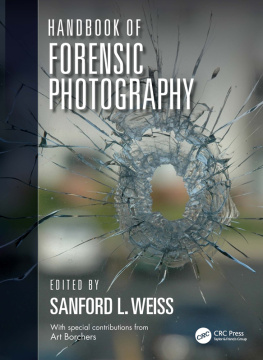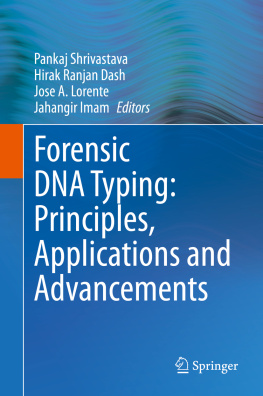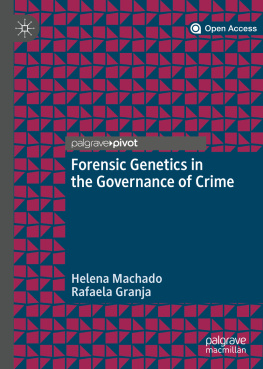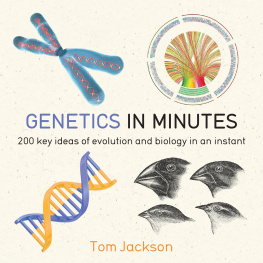

This edition first published 2011, 2011 by John Wiley & Sons Ltd
Wiley-Blackwell is an imprint of John Wiley & Sons, formed by the merger of Wileys global Scientific, Technical and Medical business with Blackwell Publishing.
Registered office: John Wiley & Sons Ltd, The Atrium, Southern Gate, Chichester, West Sussex, PO19 8SQ, UK
Editorial Offices:
9600 Garsington Road, Oxford, OX4 2DQ, UK
The Atrium, Southern Gate, Chichester, West Sussex, PO19 8SQ, UK
111 River Street, Hoboken, NJ 07030-5774, USA
For details of our global editorial offices, for customer services and for information about how to apply for permission to reuse the copyright material in this book please see our website at www.wiley.com/wiley-blackwell
The right of the author to be identified as the author of this work has been asserted in accordance with the UK Copyright, Designs and Patents Act 1988.
All rights reserved. No part of this publication may be reproduced, stored in a retrieval system, or transmitted, in any form or by any means, electronic, mechanical, photocopying, recording or otherwise, except as permitted by the UK Copyright, Designs and Patents Act 1988, without the prior permission of the publisher.
Designations used by companies to distinguish their products are often claimed as trademarks. All brand names and product names used in this book are trade names, service marks, trademarks or registered trademarks of their respective owners. The publisher is not associated with any product or vendor mentioned in this book. This publication is designed to provide accurate and authoritative information in regard to the subject matter covered. It is sold on the understanding that the publisher is not engaged in rendering professional services. If professional advice or other expert assistance is required, the services of a competent professional should be sought.
Library of Congress Cataloguing-in-Publication Data
Goodwin, William, Dr. An introduction to forensic genetics / William Goodwin, Adrian Linacre, Sibte Hadi. - 2nd ed.
p. ; cm.
Includes bibliographical references and index.
ISBN 978-0-470-71018-0 (cloth) - ISBN 978-0-470-71019-7 (pbk.)
1. Forensic genetics. I. Linacre, Adrian. II. Hadi, Sibte. III. Title.
[DNLM: 1. Forensic Genetics-methods. 2. DNA Fingerprinting. 3. Microsatellite Repeats. W 700] RA1057.5.G67 2011
614.l-dc22
2010033354
A catalogue record for this book is available from the British Library.
This book is published in the following electronic format: ePDF: 978-0-470-97307-3
Foreword
Essentials of forensic science
The world of forensic science is changing at a very fast pace. This is in terms of the provision of forensic science services, the development of technologies and knowledge and the interpretation of analytical and other data as it is applied within forensic practice. Practising forensic scientists are constantly striving to deliver the very best for the judicial process and as such need a reliable and robust knowledge base within their diverse disciplines. It is hoped that this book series will provide a resource by which such knowledge can be underpinned for both students and practitioners of forensic science alike.
The Forensic Science Society is the professional body for forensic practitioners in the United Kingdom. The Society was founded in 1959 and gained professional body status in 2006. The Society is committed to the development of the forensic sciences in all of its many facets, and in particular to the delivery of highly professional and worthwhile publications within these disciplines through ventures such as this book series.
Dr Niamh Nic Daid
Reader in Forensic Science, University of Strathlcyde, Glasgow, Scotland, UK
UK Series Editor
Preface
It is strange to consider that the use of DNA in forensic science has been with us since 1985 and, although a relatively new discipline, it has impacted greatly on the criminal justice system and society as a whole. It is routinely the case that DNA figures in the media, in both real cases and fictional scenarios. The increased interest in forensic science has led to a burgeoning of university courses with modules in forensic science. This book is aimed at undergraduate students studying courses or modules in Forensic Genetics.
We have attempted to take the reader through the process of DNA profiling from the collection of biological evidence to the evaluation and presentation of genetic evidence. Although each chapter can stand alone, the order of chapters is designed to take the reader through the sequential steps in the generation of a DNA profile. The emphasis is on the use of short tandem repeat (STR) loci in human identification as this is currently the preferred technique. Following on from the process of generating a DNA profile, we have attempted to describe in accessible terms how a DNA profile is interpreted and evaluated. In addition, databases of DNA profiles have been developed in many countries and hence there is need to examine their use. While the focus of the book is on STR analysis, chapters on lineage markers and single nucleotide polymorphisms (SNPs) are also provided. A new Chapter has also been added to this edition that provides an overview of DNA profiling of non-human species.
As the field of forensic science and in particular DNA profiling moves onwards at a rapid pace, there are few introductory texts that cover the current state of this science. We are aware that there is a range of texts available that cover specific aspects of DNA profiling and where there this is the case, we direct readers to these books, papers or websites.
We hope that the readers of this book will gain an appreciation of both the underlying principles and the application of forensic genetics.
Preface to first edition
It is strange to consider that the use of DNA in forensic science has been with us for just over 20 years and, while a relatively new discipline, it has impacted greatly on the criminal justice system and society as a whole. It is routinely the case that DNA figures in the media, in both real cases and fictional scenarios.
The increased interest in forensic science has led to a burgeoning of university courses with modules in forensic science. This book is aimed at undergraduate students studying courses or modules in Forensic Genetics.
We have attempted to take the reader through the process of DNA profiling from the collection of biological evidence to the evaluation and presentation of genetic evidence. While each chapter can stand alone, the order of chapters is designed to take the reader throught the sequential steps in the generation of a DNA profile. The emphasis is on the use of short tandem repeat (STR) loci in human identification as this is currently the preferred technique. Following on from the process of generating a DNA profile, we have attempted to describe in accessible terms how a DNA profile is interpreted and evaluated. Databases of DNA profiles have been developed in many countries and hence there is need to examine their use. While the focus of the book is on STR analysis, chapters on lineage markers and single nucleotide polymorphisms (SNPs) are also provided.
As the field of forensic science and in particular DNA profiling moves onward at a rapid pace, there are few introductory texts that cover the current state of this science. We are aware that there is a range of texts available that cover specific aspects of DNA profiling and where there this is the case, we direct readers to these books, papers or web sites.
Next page






